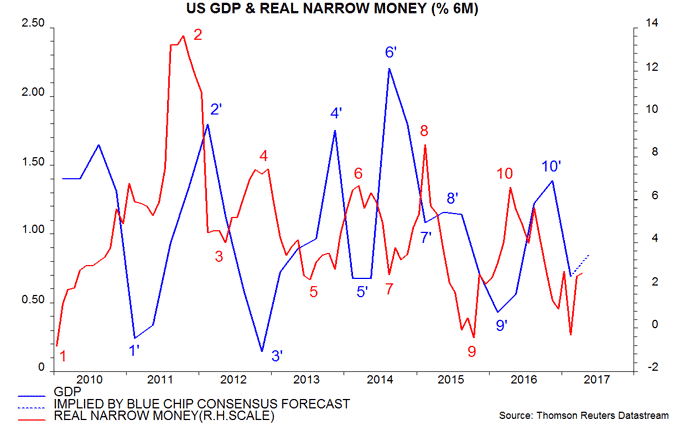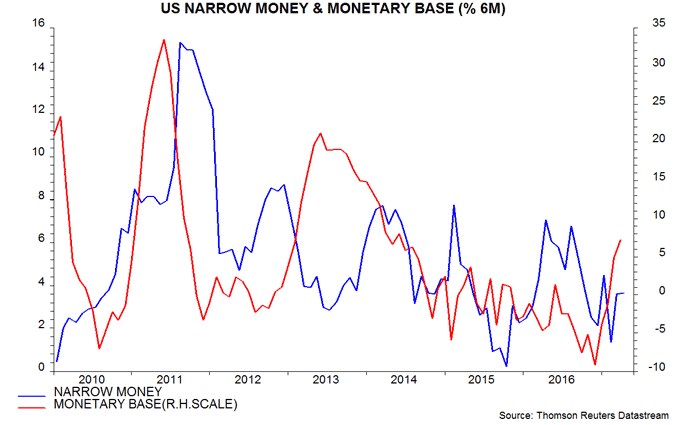Is US money growth reviving?
US GDP growth undershot consensus expectations in the fourth quarter of 2016 and first quarter of 2017, as had been signalled by real narrow money trends last summer. Real money growth may be starting to recover but recent weakness suggests that a significant rebound in economic momentum will be delayed until late 2017.
As discussed in previous posts, turning points in six-month growth of real (inflation-adjusted) narrow money growth have consistently led peaks and troughs in two-quarter GDP expansion in recent years. The labels in the first chart pair up turning points in the two series. The consensus was bullish about economic prospects last autumn but six-month real money expansion had peaked in April 2016 and was falling sharply, signalling likely disappointment. GDP momentum duly slowed markedly in the fourth and first quarters.
The consensus claims that seasonal adjustment problems and other “special” factors artificially depressed the first-quarter result. The Blue Chip consensus forecast is for quarterly annualised GDP growth to recover from 0.7% in the first quarter to 2.7% in the second. This would still leave two-quarter GDP expansion significantly lower than in the third and fourth quarters of 2016 – first chart.
Six-month real narrow money growth bottomed in February, recovering modestly in March and April – the last data point in the chart is an April estimate based on weekly data through 24 April and an assumed 0.2% monthly rise in consumer prices. The lead time between real money growth and GDP growth has averaged about six months recently, suggesting that economic momentum will start to revive at the end of the third quarter.
A further recovery in real narrow money growth is needed to “confirm” this scenario. The forecasting approach here uses monetary data to assess economic prospects but does not attempt to predict monetary trends, since there is no reliable method for doing so. Several recent developments, however, are consistent with a real money revival.
First, recent commodity price weakness is likely to result in a slowdown in six-month consumer price inflation, implying a rise in real money expansion assuming that nominal growth is stable – second chart.
Secondly, the monetary base has sometimes led narrow money in recent years and has recovered significantly so far in 2017 after contracting in late 2016 – third chart. This contraction reflected a rise in the Treasury’s balance at the Fed and greater use of the Fed’s reverse repo programme, both of which have reversed in 2017.
Thirdly, narrow money growth has been loosely correlated, inversely, with the two-year swap spread, with the spread sometimes leading – fourth chart. The spread has fallen recently, consistent with the upturn in money expansion.
A further recovery in real narrow money growth would suggest a stronger economy in late 2017. Treasury yields could move higher in anticipation of this prospect and as upward pressure on wage growth keeps the Fed on a tightening tack.

Reader Comments